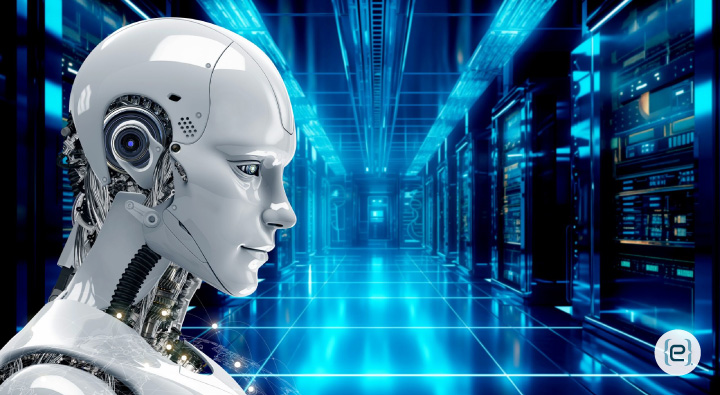Artificial Intelligence


The 21st century has seen an information revolution, with AI (Artificial Intelligence) one of the pinnacles. Text At its core, AI is rapidly changing industries and streamlining workflows, rewriting how we collaborate with technology. We are all aware of applications such as Self-Driving cars and Virtual Assistants (Siri, Alexa) from this technology. But what exactly is AI, and how does it work? Artificial Intelligence is the computer simulation of human intelligence. A device made in this way may be designed to behave in any manner that can be characterized as possessing intelligence.
AI is not limited to understanding natural language and being able to make decisions. AI is designed to have the power to perform and execute tasks that would otherwise require human intelligence, from simple ones like recognizing patterns, to complex ones like autonomous vehicles and playing chess. AI systems with the ability to analyze large volumes of data can be used to detect patterns in data that can then inform decisions far more quickly and accurately than a human ever could. This is what makes artificial intelligence so efficient in use cases such as automation, natural language processing and predictive analytics.
The Core Components of AI
- Machine Learning (ML): ML refers to a machine’s ability to learn from data and improve over time without the help of additional coding machine-learning algorithms.
- Natural Language Processing: NLP is a field of AI & computer science, that studies the interaction between computer and human language. Text analysis using Natural Language Natural language processing (NLP) allows machines to interpret and produce human language in meaningful ways. Examples of natural language NLP are voice-activated virtual assistants such as Google Assistant chatbots and language translation services.
- The Networks of Neural Structure: a network is nothing more than an array of algorithms, known as neural networks, that are designed to recognize patterns and behave just like the human brain. These networks are composed of connected layers, which represent information-processing nodes (neurons). Deep learning is a subset of machine learning and neural networks that are multiple layers deep, which provide breakthroughs in areas such as natural language processing using unimaginable amounts of data.
- Computer vision: Computer vision is an AI domain that enables machines to interpret information either from images or video sources. Computer vision systems can recognize objects, analyze images, and process the data in real-time using digital images or videos. This tech is used in applications, such as those that drive facial recognition on driverless cars or read images to aid in medical diagnostics.
Types of AI
- Narrow AI systems: These types of systems are designed for a particular task or group of tasks. They are effective, while completely lacking any sense of awareness and self. An example of narrow AI is facial recognition software chatbots in customer support recommendation engines on streaming services like Netflix. Narrow AI can outperform humans at certain tasks, but beyond that it’s brain dead (Stephen Hawkings and Elon Musk indicated this specific utilization might be far better described as “automation” or even “advanced statistics”).
- A strong AI or a general AI: In principle, general artificial intelligence (or an AI) should be edge-complete, and can do any intellectual work that a human could perform. Because it can learn new things from data, a general artificial intelligence system would be as flexible and adaptable as the human mind. However, general artificial intelligence remains only theoretical and is a long way off.
- Superintelligent AI: Superintelligent AI — a level of intelligence much like that of humans but in ways almost more intelligent, particularly with regards to creative diverse thinking problem solving, and social interaction. While largely theoretical, this notion has raised alarms among researchers and ethicists, who have called for guarantees that AI will continue to be under human control in the future.
AI Applications
AI is increasingly finding applicability across a variety of sectors, leading to innovation, accelerated productivity and addressing complex issues. These are some of the most well-known applications of AI.
- Healthcare: Artificial intelligence in healthcare is nothing short of a revolution. The processing has yielded benefits like customized treatment plans, streamlined administrative functions, and improved diagnostics. Machine learning algorithms are being used to analyze patient records, imaging scans, and others to detect cancers and other conditions early on. Drug discovery can also benefit from AI systems that will comb through vast datasets in search of potential treatments.
- Finance: Artificial intelligence helps to develop algorithmic trading fraud detection, and personalized financial services. Machine learning algorithms can study transaction patterns to find anomalies and, thus alert potentially fraudulent activity. Additionally, AI-powered robot-advisors are becoming common for providing personalized investment advice according to the financial goals of clients.
- Self-driving Cars: The development of autonomous cars is one of the most interesting applications of AI. The AI system lets an autonomous vehicle look at all that surrounds it, so the vehicle can drive on a road and avoid crashing into anything. Companies like Tesla, along with Waymo and Uber — are pouring billions into AI to win the autonomous driving race. Autonomous driving has the potential to revolutionize transportation while dramatically reducing traffic accidents on roadways.
- Retail: Companies use artificial intelligence to enhance marketing communication, optimize supply, and provide customer fulfilment. Retailers are using AI to predict demand, study customer behavior and offer tailored recommendations, while AI chatbots and virtual assistants provide real-time customer support and answer product-related questions.
- Production: AI can improve quality control, reduce waste and optimize the processes using it. The machine learning algorithm will monitor the sensor data and can predict failures so that timely maintenance may be scheduled which reduces downtime whereas robots are being used more and more in factories as AI-powered to automate repetitive tasks.
AI is enhancing productivity and revolutionizing the way businesses are run. Your eMazzanti professional can help guide you and your business as you navigate this exciting, emerging development.
Recent Posts
The Rise of AI Agents: Simplifying Tasks and Connecting Technologies
Introducing eCare Bot: Your Intelligent IT Support Assistant In today's fast-paced world, the emergence of…
Server Simplified
At eMazzanti Technologies, we recognize that stable, effective, and expandable servers are essential to the seamless operation of enterprises. For this reason, we collaborate with Hewlett Packard Enterprise (HPE) to offer our clients the best server solutions possible, customized to meet their unique requirements. HPE servers provide the performance and flexibility required for small and big businesses to manage data, support apps, and manage workloads with ease. Customers may choose the best HPE servers for their organization with the assistance of our team of specialists. We take the time to comprehend the particular needs of every client, including those related to processing speed, storage capacity, and security features. Whether our clients require a general-purpose ProLiant server or a…
How to Make Your AI Copy Sound Authentic: Writing Like a Human, Not a Machine
AI writing tools have become popular for creating content quickly. But many readers can spot…
Data Analytics for Old-School Business Owners: Turning Dusty Ledgers into Gold Mines
Data analytics is changing the game for businesses of all types, including old-school industries that…
Windows Snipping Tool Tips and Tricks: Mastering the Art of Screen Capture
The Windows snipping tool is an extremely convenient utility for capturing screenshots quickly. It serves…
Harry Potter with a Lightsaber: A Wizard’s Guide to Space Magic
What if Harry Potter swapped his wand for a lightsaber? Explore the hilarious and chaotic…


